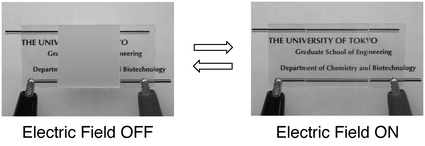Electrooptical properties of liquid-crystalline physical gels: a new oligo(amino acid) gelator for light scattering display materials†
Abstract
Nematic liquid-crystalline (

* Corresponding authors
a
Department of Chemistry and Biotechnology, School of Engineering, The University of Tokyo, Hongo, Bunkyo-ku, Tokyo 113-8656, Japan
E-mail:
kato@chiral.t.u-tokyo.ac.jp
b Department of Bioscience and Textile Technology, Graduate School of Science and Technology, Shinshu University, Ueda, Nagano 386-8567, Japan
Nematic liquid-crystalline (

 Please wait while we load your content...
Something went wrong. Try again?
Please wait while we load your content...
Something went wrong. Try again?
N. Mizoshita, Y. Suzuki, K. Kishimoto, K. Hanabusa and T. Kato, J. Mater. Chem., 2002, 12, 2197 DOI: 10.1039/B201484J
To request permission to reproduce material from this article, please go to the Copyright Clearance Center request page.
If you are an author contributing to an RSC publication, you do not need to request permission provided correct acknowledgement is given.
If you are the author of this article, you do not need to request permission to reproduce figures and diagrams provided correct acknowledgement is given. If you want to reproduce the whole article in a third-party publication (excluding your thesis/dissertation for which permission is not required) please go to the Copyright Clearance Center request page.
Read more about how to correctly acknowledge RSC content.
 Fetching data from CrossRef.
Fetching data from CrossRef.
This may take some time to load.
Loading related content
